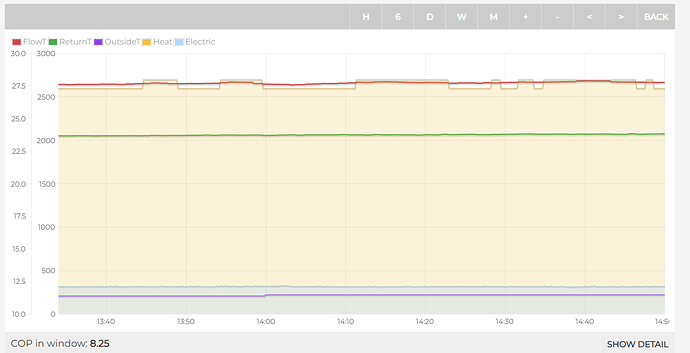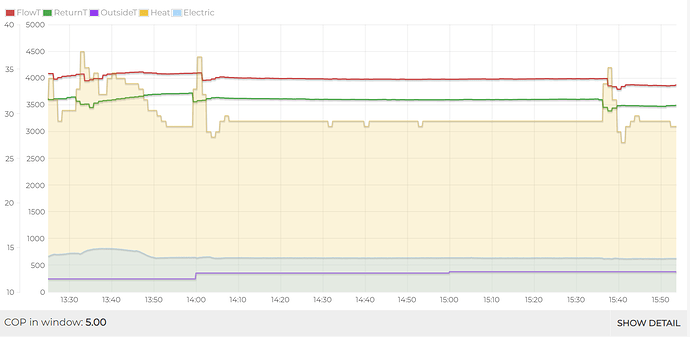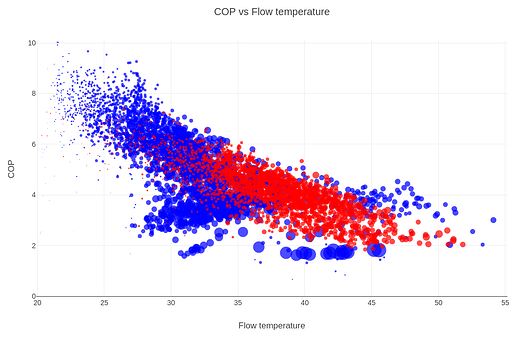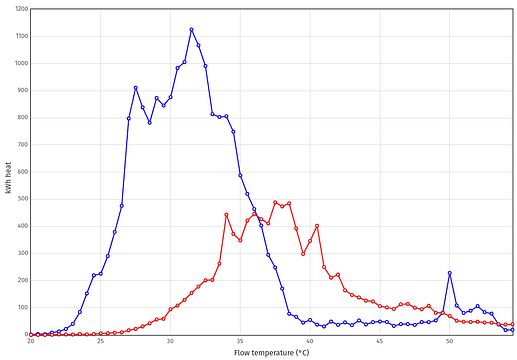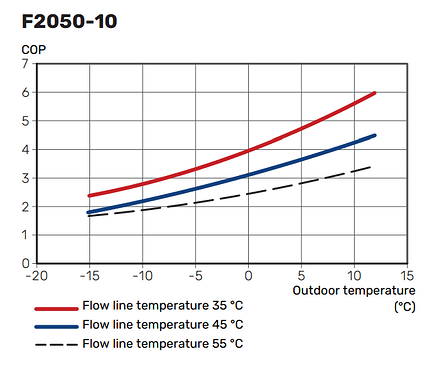Hi. Sorry for my english - I’m from Bulgaria. Recently looking through heatpumpmonitor.org I noticed some absurd efficiency readings for some installers :-). Will not mention names because I think it’s a sensitive theme for some people. Is it possible to manipulate the data monitored? I know it’s possible but have to ask… I must make a notice that the need for mega high COP for some installers would make the whole idea for this site completely useless…
We do carefully double-check the data for systems submitted to heatpumpmonitor and flag the ones with unrealistic performance. Many of the top systems are using MID approved metering, so there’s usually a high degree of confidence in the readings they’re providing.
With mild temperatures for the last 30 days averaging around 10°C it’s not too surprising that the top systems are managing COP above 5.0, especially given that these are some of the best trained engineers.
You think an air to water system can make COP of 8 and the same system cycle and make COP of under 3 at outside temperatures in the range of 3 to 7 degrees?
Might be useful if you could point to a system you find suspicious, I don’t think anyone would mind. Also note that there are a few ground source pumps that will show a much better performance and less correlation to outside temperature.
I can see that with a heat pump that modulates down really low, a system with insufficient emitters to work well in low temperatures could easily work very well when much warmer.
I don’t see any systems running at a steady COP of 8, some show quite high instantaneous COP’s but over 30 minutes they are more reasonable.
I agree with Andre, point to the ones you are interested in, nobody will mind, we all may learn something.
It is fairly easy to manipulate the data, I apply a -0.3C offset to my LWT to account for discrepancy between my two sensors, but could easily do the opposite.
It’s more likely to be metering issues though?
Hi Ben,
If I understand correctly you are adjusting your lwt downwards?
If so, that is commendable.
But it may be wrong.
The sensors in our heat pumps may have been calibrated to be accurate within the normal operating temperature ranges of the heat pump and could easily drift outside that range.
I don’t know, of course.
And that is the problem with non MID monitoring, you just don’t know.
I honestly mean no offence to anybody, I just wish EspAltherma in particular wasn’t a thing.
My interest and knowledge is in Daikin as that is what I have and know.
I know it costs a little more, but in overall terms proper heat and electricity meters are not very expensive over their lifetime.
Anything else is just polishing a turd in my opinion and has no place being with properly monitored systems.
It’s my opinion and I apologise if it offends anybody, it 's how I feel and I feel quite strongly about it.
They cause too much confusion and uncertainty, nobody can be really sure what they are looking at and they have caused me countless hours of chasing my tail trying to replicate something that wasn’t real.
“When you can measure what you are speaking about,
and express it in numbers, you know something about it”
– Lord Kelvin
What system are you referring to? All the top performing systems use MID approved monitoring hardware, and we control the data acquisition and processing.
It’s quite mild now in the UK, some systems are showing very high COP figures, e.g delivering 25C flow temperature from 16C ambient air! However, this is obviously not representative of a full heating season, only a small % of heat is delivered during these shoulder heating seasons. It’s better to change the data period to 90+ days and have a look at the SCOP figures to get a better picture of overall performance.
The system is air to water.
Outside - 11.5 degrees.
Returnt temperature 23.7 degrees.
COP 8.25 for at least an hour. R32 refrigerant :-).
Same system:
Outside 5.9 degrees.
Returnt 28.5 degrees.
The screen is just few months earlier.
This is a system from the back of the field. Vaillant 5 kW - normally performing at 12.3 degrees :).
Please can you post a link to the system in question?
Flow temperature at 27.5°C, electrical power at 400 W in warm air.
Flow temperature at 37°C, electrical power over 4kW in cold air.
It’s not too surprising to see lower performance when the heat pump is working hard to deliver 12 kW of heat in cold weather, compared to it just ticking over in warmer weather.
This is the 9 kW, Nibe F2050-10 in Bristol
Compared to a similar unit (Cadross, Dumbarton) (red) we’re seeing similar levels of COP vs. Flow Temperature (Jan - April), yet the one in Bristol (blue) is running at much lower temperatures.
Thanks, the maximum carnot efficiency I can see for this system is 65% which is high but plausible. You can enable carnot efficacy under the ‘show details’ section. In this particular example heat pump is delivering a very low flow temperature of 25C with a relatively high outdoor temperature of 10C
However, overall the system has a SCOP of 4.78
This system is using MID approved heat and electricity meter. However, as you can see on heatpumpmonitor this system is not monitoring the electricity used by the internal controller or the circulator pump which is probably around 100W total: https://heatpumpmonitor.org/system/view?id=65. If an extra 100W of electricity was included, this would reduce the COP in this example of 8 to 6. We push all installers to include the energy used by all pumps in the system, but if they choose not to, it’s fine as long as this is clearly stated on the heatpumpmonitor form, which it is in this case.
There’s no data for 25C flow!
Trystan wrote about System Boundaries in this post:
Just wondering on the reasoning behing why pump power should be included in the COP? When I want to compare a heat pump to a gas boiler, I care about how much primary energy is used to get a specific amount of heat into the house. The electrical energy used by the lump goes into the auxiliary energy use of the gas boiler, the heat energy comes from burning the gas. Assuming I’m targeting the same flow temperature, a gas boiler will use the same electrical energy to pump the water around as a heat pump. Now if I want to know exactly how much energy I’m saving by using a heat pump, shouldn’t I look at COP without pump energy included?
I’m wondering what type of system have to be used to manage heating with flow temperature of 25 degrees and return of 23 degrees? I think to heat a swimming pool we need higher temperatures?
